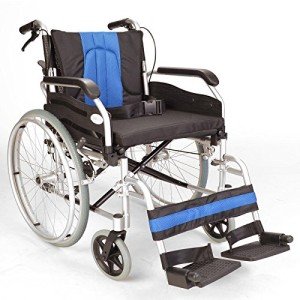Seven Reasons To Explain Why Bariatric Wheelchair 24 Inch Seat Is Important

Bariatric Wheelchair Seat Width
Seat Width
Having the correct seat width is essential to wheelchair users who invest longer periods in their chairs. Too narrow a seat will trigger pressure on the hips and thighs which might result in sores or pressure points. Having too wide a seat can also make it tough for the user to reach the hand rims to move themselves or maneuver in little spaces.
To determine the correct seat width an individual would sit on a chair normally and have their measurement taken throughout their lap at the best point which is usually their hips. A wheelchair determining tape can be used to determine this, however a backyard stick is chosen as it prevents individuals from wrapping the tape around their hips which would give an inaccurate outcome.
The basic wheelchair seat width is 16" (narrow adult), 18" (standard grownup), and 20" (large adult). For bariatric patients, a 24" seat is readily available. This heavy-duty extra large bariatric wheelchair from Medline features swing-away footrests, a carbon steel frame with rust- and chip-resistant chrome plating, and easy-to-clean vinyl upholstery. It has a weight capacity of 500 pounds.
Seat Depth
Traditionally, the seat depth of a bariatric wheelchair was added 2" to the measurement taken at the user's largest point (generally their hips). This was meant to accommodate additional layers of clothing that may be worn during winter. However, this practice is becoming less common as wheelchair users are able to spend more time inside your home and are not using long coats. This makes the seat depth of a chair lesser when picking a bariatric wheelchair. Nevertheless, it is still crucial to pick a choice that provides appropriate assistance for larger users.
The Medline folding additional broad bariatric manual wheelchair features a comfy 24" seat width and a durable slide tube silver vein frame. It also has an adjustable axle and tool-free elevating legrests.

Seat Height
When it concerns figuring out the right wheelchair seat width you need to always determine from the user's best point which is typically their hips. You will likewise require to consider whether the user is going to be using a winter season coat as this might add 2" to the width needed.
When a wheelchair remains in use it must only be operated on level surface areas with the wheel locks totally engaged. take a look at the site here is to prevent the chair from being able to move inclines that are 10 degrees or higher. It is likewise essential to keep in mind that any activity that might shift the center of mass in the chair ought to be made with care. This includes grabbing products that need the individual to lean out of their seat or attempting to stand from it.
Whenever you have the chair in usage it is recommended that you frequently inspect it for damage and lubricate any locations that are deemed needed. For example, the casters must be oiled by getting rid of the caster fork and using a multi-purpose grease to use to the caster stem bearings. Similarly, the foot plates can be changed by loosening the bolt and after that moving them to the wanted position. This allows the feet to sit comfortably on the footplate and avoids any pressure points from forming. This can be very uncomfortable for the user and if left unattended, can result in pressure sores.
Weight Capacity
Bariatric wheelchairs are developed to support more weight than basic wheelchairs. This makes them tougher and much better geared up to manage falls. They are likewise typically bigger and wider, making them less maneuverable in tight areas than standard wheelchairs. They need automobiles with unique ramps and lifts to pack them, as well as chauffeurs who understand how to best transport them from one place to the next.
When picking a wheelchair, consider its weight capacity as it will be the primary determining consider whether it will accommodate your traveler's requirements. The weight capacity of the chair is typically listed as a fixed load, suggesting that it suggests the quantity of weight the chair can easily hold while stalling. However, some producers likewise note an active load that is based on a drop test and can simulate the effect of somebody taking a seat in the chair. This may be a more trustworthy measurement of the weight limit, depending upon your requirements.
If you plan to perform activities that move your center of mass in the seat (such as reaching for items), make sure to have front casters pointed in a forward instructions and wheel locks engaged so the chair will not tip over. Also, check that casters are lubricated routinely to avoid extreme wear and abrasions. The lubrication procedure includes eliminating the fork, separating the caster from the wheel, and greasing the caster stem bearings with high-quality multi-purpose grease.
